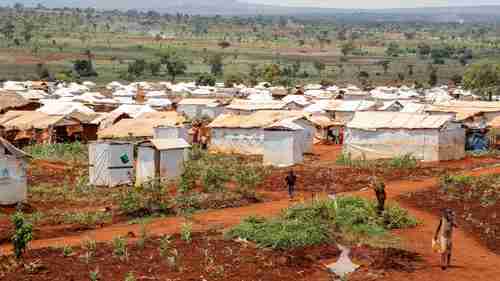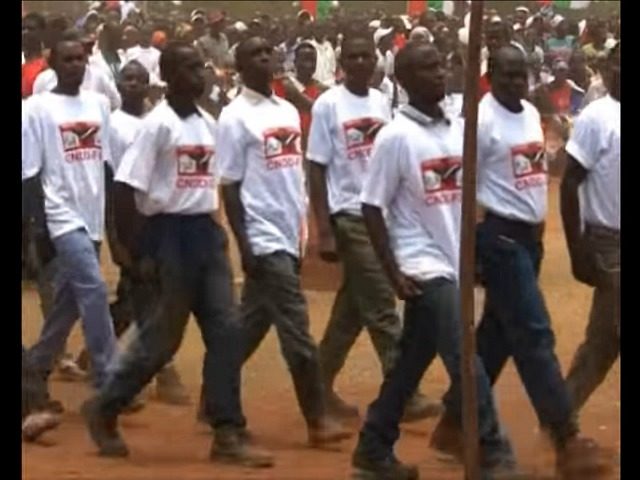This morning’s key headlines from GenerationalDynamics.com
- UN: Burundi’s Hutu government attacks on Tutsis are crimes against humanity
- Violence by the Imbonerakure, Nkurunziza’s ‘visionary’ youth wing
UN: Burundi’s Hutu government attacks on Tutsis are crimes against humanity

Nyarugusu refugee camp in Tanzania. Over 400,000 people have fled to other countries to escape the Burundi government violence (MSF)
A final report issued on Monday by a special UN Commission of Inquiry on Burundi has found massive human rights violations by the government of president Pierre Nkurunziza, an ethnic Hutu, to the level of crimes against humanity.
The report was based on interviews with more than 500 people among the over 500,000 who had fled the country from the violence. The violations included torture, rape, beatings, arbitrary jailings and summary executions. The investigators were not permitted to enter the country for the investigation.
A year ago, there was an initial United Nations report on Burundi, documenting torture, sexual violence, arbitrary jailings, targeted assassinations and summary executions. The targets of this massive violence were mostly political opponents.
Nkurunziza’s reaction to that report was to ban the United Nations from Burundi, and to withdraw Burundi’s membership from the International Criminal Court (ICC). However, a withdrawal does not take effect for a year, and the year is not up until October. For that reason, the UN is strongly recommending that the ICC take up an investigation immediately, before the withdrawal takes effect. Reuters and United Nations and Deutsche Welle
Related Articles
- Burundi’s Pierre Nkurunziza follows Syria’s Bashar al-Assad on path to genocide (13-Oct-2016)
- 20,000 refugees flee violence in Burundi, fearing Hutu-Tutsi war (30-Apr-2015)
Violence by the Imbonerakure, Nkurunziza’s ‘visionary’ youth wing
The violence began in June 2015, after Nkurunziza announced that he was going to run for a third term as president, in violation of the country’s constitution. There were peaceful protests, which Nkurunziza countered by killing anyone who protested. Tens of thousands fled to neighboring countries to escape the violence.
Today, there are almost 500,000 registered refugees in neighboring countries, including 237,000 in Tanzania, 86,000 in Rwanda, 35,000 in Uganda, and 37,000 in Democratic Republic of Congo. Three-quarters of the refugees are Tutsis.
In the 1994 Rwanda genocide, which also took place in Burundi, the ethnic Hutus slaughtered close to a million Tutsis in a three-month period. Today’s targets of Nkurunziza’s violence are not necessarily Tutsis, but are anyone who is politically opposed to Nkurunziza. However, the vast majority of the targets are the Tutsis, since most of Nkurunziza’s political opposition comes from Tutsis.
The UN found that the crimes that violate international law were committed by members of the National Intelligence Services, Burundi’s national police and the army.
A major participant in the violence is the Imbonerakure, the youth wing of Nkurunziza’s political party. The word Imbonerakure means “visionaries,” and for these kids, being “visionary” means raping women and beating people with iron bars. Reports in 2015 indicated that Nkurunziza’s police would select targets in the opposition, and would give kids in the Imbonerakure police uniforms, along with instructions to go to the homes of the targets, kill the men with iron bars, rape the women, and then kill the women and children.
Burundi is in a generational Awakening era, following the 1994 genocide. From the point of view of Generational Dynamics, we have seen this time after time: in Syria, Zimbabwe, South Sudan, Burundi, Thailand, Uganda, Democratic Republic of Congo, Cameroon, Eritrea, and other countries, where leaders in generational Awakening and Unraveling eras use arbitrary jailings, violence, and atrocities to keep the opposition ethnic group out of power. Over a period of years, the violence worsens until it turns into a full-scale generational crisis civil war when the next generational crisis era arrives.
It is worth recalling what happened during America’s last generational Awakening era in the 1960s-70s. There was plenty of street violence by young people in Los Angeles, Detroit, and Chicago, during the “long hot summers.” There was also targeted violence by left-wing and anarchist groups such as the Weather Underground. There was similar violence in Europe and other countries during the “Revolution of 1968.” UN OHCHR (18-Apr) and “Stand Now and NPR (7-July-2015)
Related Articles
- Burundi’s Nkurunziza continues down Mugabe-Assad path of genocide (10-Dec-2015)
- Boomers commemorate the 40th anniversary of the Summer of Love. (12-Jun-2007)
KEYS: Generational Dynamics, Burundi, Pierre Nkurunziza, Hutu, Tutsi, International Criminal Court, ICC, Tanzania, Rwanda, Uganda, Imbonerakure
Permanent web link to this article
Receive daily World View columns by e-mail

COMMENTS
Please let us know if you're having issues with commenting.